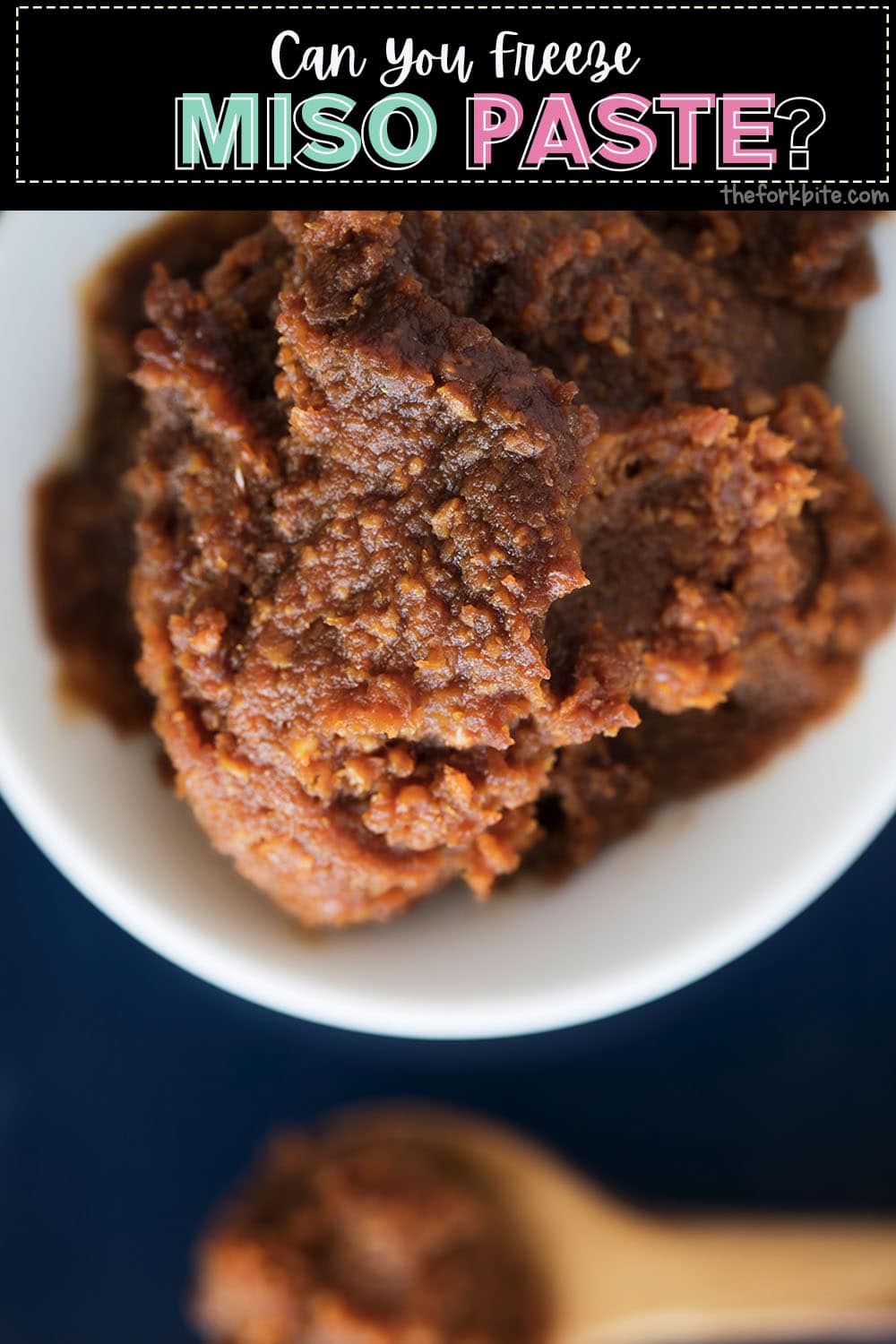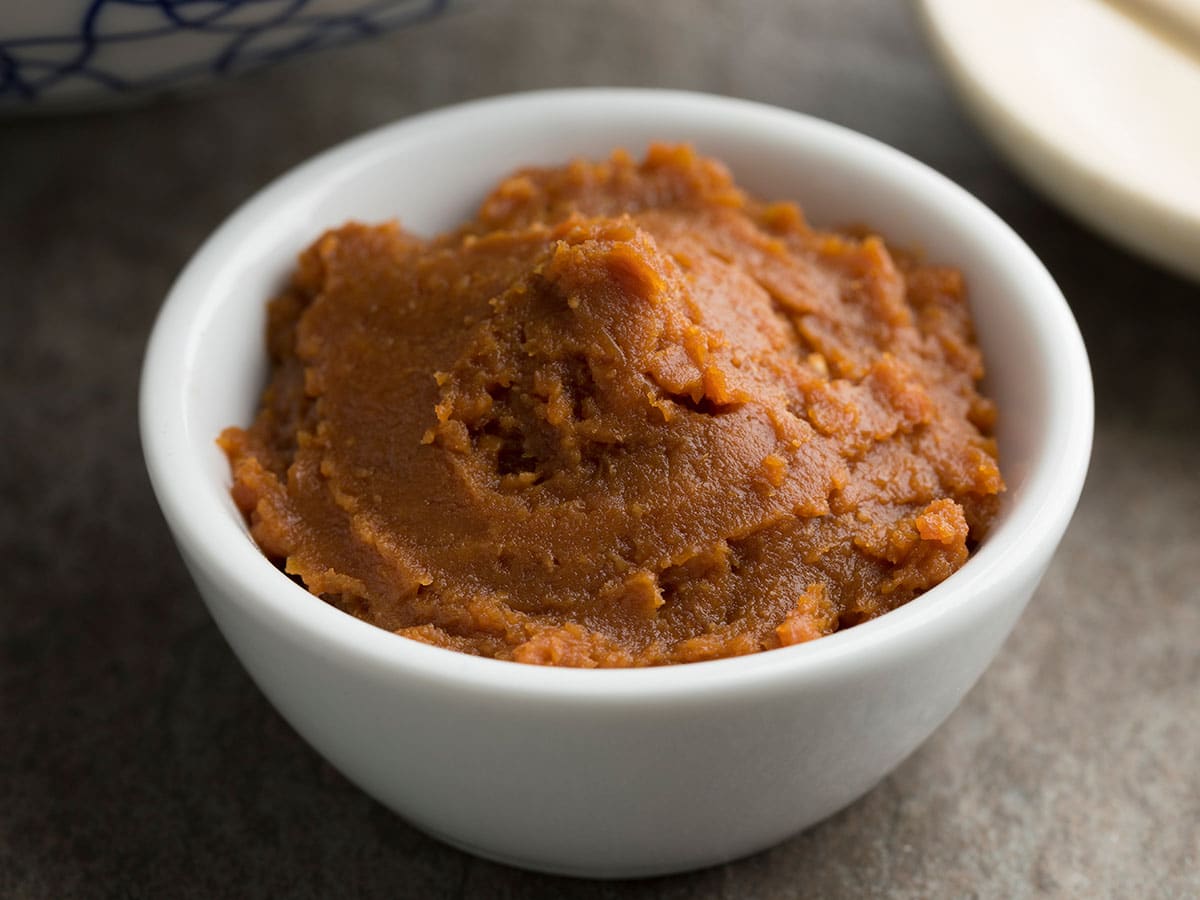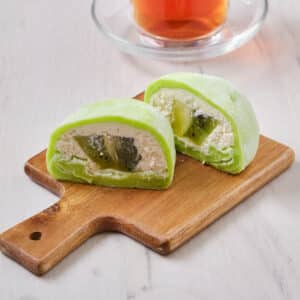Once upon a time, the western world only recognized four basic tastes - bitter, salty, sour, and sweet.
Now, our darkness has been lightened, and we acknowledge that there is a fifth. Yes, of course, it's umami.
The New Yorker's food critic, Hannah Goldfield, describes the taste of umami as being a deep, dark, meat-like intensity reminiscent of things like anchovies, seared beef, cheese, mushrooms, Parmesan, tomato, and soy sauce.
It's a savory deliciousness that we have all experienced many times, and households now have miso paste (umami heaven) as a regular item in their pantries.
Jump to:
Can you freeze miso paste?
Regrettably, it is not always easy to buy miso paste in anything other than large tuns. While buying a tub of this deliciousness means that you'll have it around for a while, as it is only used in relatively small quantities; that is only the case if you know how best to store it.
Yes, you can keep it in your fridge for a while, but if you want to keep it for longer, you might like to know whether or not you can freeze it.
The answer is yes, you can. You could not only freeze miso paste, but you can also freeze miso soup, and the great thing is that if you know how to prepare it in the right way for freezing.
You can keep it for up to 6 months before any risk of losing a little of its amazing umami taste.
The taste of umami - a Japanese word meaning "essence of deliciousness," is encapsulated perfectly in miso paste.
Miso is very convenient and easy-to-use in its paste form, something you don't want to miss if you freeze it.
So I'm going to go over a few ways you can freeze miso paste that will make it more user-friendly when you need it.
The best ways of freezing miso paste
You can go about freezing miso paste several ways, and I will start with the plastic bag method.
#1 The plastic bag method
The advantages of freezing miso paste in an airtight plastic bag (please note the use of the word "airtight") are:
- It will prevent it from being contaminated.
- It can be stored flat in your freezer, thus saving space.
If you want to store it in a tub, you will need to make sure that it is as full as possible as you don't want to store it with too much air.
If going down the plastic bag route, you need to get as much air out of the bag as you can. Food vacuum sealers are perfect for this sort of job.
When using the plastic bag method of storage, you might want to consider double wrapping it as an added protection against the miso absorbing the flavors from other foods in the freezer.
#2 The ice tray method
A neat little trick is to freeze miso paste in an ice cube tray. This method gives you a nice little usable portion with each cube.
Don't worry; it will be easy to take it out cube by cube as miso paste remains reasonably soft when frozen.
The fact that miso paste stays quite malleable after freezing is also useful if you store it in a tub because you can relatively easily spoon out as much as you need without having to go through the rigmarole of defrosting the whole tub.
#3 The small container method
You may prefer to freeze your miso paste in several small, separate containers.
Like the ice cube tray method, it means that you get a more usable portion size, and it makes it easier to defrost.
Label and date
Miso paste will keep in your freezer almost indefinitely, but it is recommended to use it within six months.
If you label and date each container or plastic bag, it makes it easier to recognize when it's probably past its best, i.e., after six months.
Three types of miso paste
There are three different types of miso paste which can be classed as white, red, and mixed. The lighter pastes don't last as long as the darker ones once the container is opened, impacting what you decide to freeze and when.
As a guide, lighter-colored pastes will keep for nine months after opening, whereas darker ones will be good for up to 18 months.
Defrosting miso paste
It's not always necessary to defrost frozen miso paste as it remains reasonably soft even after freezing. If you're going to be putting it into a soup or stew, you can dollop it in there straight from the freezer.
When put into hot or near-boiling liquid or sauce, it defrosts in only seconds.
If you want to defrost it, the best way to do so is to transfer the miso paste from the freezer into your fridge and leave it for a couple of hours.
All about miso paste
If you decide to make your own miso paste, you're going to have to be patient. It takes at least six months to mature. If you want to have a go, here is a recipe from chopstickchronicles.com.
Amazing though it sounds, according to the Japanese miso promotion Board, there are over 1300 different types of miso.
Miso paste is a mash of:
- Cooked soybeans
- Rice Koji - steamed rice injected with a fermentation culture
- Salt - sun-dried unrefined sea salt works best
- Water
Each varies in terms of:
- Color, smell, and taste
- Where it was made
- Which type of koji was used
- The ratio of koji to soybean
- The length of time for which it fermented
- The conditions under which the fermentation took place
- As you can tell, it's something of an art form.
What does miso taste like?
As mentioned earlier, there are various colors of miso paste. They range from a pale tan through red to dark brown. With each change of color, the flavor subtly varies.
I re-counted Hannah Goldfield's description of miso paste's taste earlier; it has a special salty, savory, tangy taste all of its own.
Lighter-colored miso pastes have a slight sweetness about them. Texture-wise, pastes can vary from utterly smooth to somewhat chunky.
Fabulous though the taste of miso paste is on its own, it's not created to be eaten unadulterated. Instead, it is added to impart its funky umami flavor to various dishes, including marinades, sauces, soups, and stir-fries.
The fact that miso paste is a fermented product means it contains probiotics that are good for your digestion and overall health.
As you may know, products containing probiotics should never be boiled as it kills off any healthy bacteria.
Store-bought miso paste
When you're out and shopping, you will mostly come across miso paste labels reading red or white.
It's because of how the manufacturers make it and label it for the American market. The terms are somewhat misleading.
What is labeled white miso paste can be anywhere from light yellow to beige. According to Nancy Singleton Hachisu, the Japanese classify red miso as dark in various shades of brown.
Regarding what in America is sometimes called "yellow miso," Nancy, an expert on Japanese culture and cuisine, says that she is not sure what "yellow" refers to.
But, the darker the color of miso paste and the longer it has been aged, the saltier and more complex the taste.
Nancy's parting shot on the subject of commercial miso paste is that it is produced relatively quickly and is oxidized, making it darker than miso paste made in the traditional Japanese way.
The different types of miso paste
As I said earlier, there are hundreds of different types of miso paste around.
As with many foodstuffs from China and Japan, there are claims about its health benefits, and some say that miso helps to neutralize the side effects of smoking and radiation.
It is also said it can discourage the growth of cancer cells and be used to help break down cholesterol.
Miso is also fabled to be able to preserve skin health and delay the effect of aging.
Whether or not any of these claims are true doesn't matter as the main thing is its wonderfully distinctive flavor.
It certainly won't do you any harm to eat more, and why not? It is, after all, completely delicious.
The terminology used when talking about miso paste.
The terminology used when discussing miso paste includes some Japanese words that you may not be familiar with, so here is a sort of glossary to help out.
#1 Shiro miso paste
You probably know this as white miso paste. It is a little sweet and is one of the most popular varieties.
It is made with a high proportion of rice to soybean and fermented for a relatively short time, i.e., from a few days to about three months.
It is usually quite smooth and creamy and dissolves quite quickly. It can also sometimes be found with a slightly more chunky texture.
In taste, it is more mild than pungent and is likened to a young cheese. It lends a nice complexity of flavor to the dishes it is added to.
It is typically used in soups and dressings or st a marinade or glaze when cooking fish or meat.
#2 Sendai miso paste
This miso paste is dark brown, quite salty, and contains small beans and rice. Elizabeth Andoh, an author of five Japanese cookbooks and a graduate of the Yanagihara School of Classical Japanese Cuisine, says it's a wonderful flavoring for burgers, meatloaf, pasta sauce, and ratatouille.
#3 Aka miso paste
This one you may know as red miso. In reality, its color is anything from a medium red to being almost black, and texture-wise it is typically quite chunky.
It is fermented for longer than some other types of miso - anywhere from one year to three. The miso to rice proportion is higher than white miso, and it often contains barley or rye.
It has a distinctive flavor of rich, salty umami. Because of its stronger taste is best added to more hearty dishes such as braised pork belly and mushroom risotto.
#4 Hatcho miso paste
This miso has a dark rich, and smoky taste and originated in China. Hatcho miso paste contains only soybeans.
It is similar to hoisin sauce and is often dolloped onto tofu and vegetables. It is also sometimes used in soups. Color-wise, it is a very dark brown.
#5 Genmai miso paste
This miso paste is sometimes referred to as brown miso as it is made from brown rice koji. In color, it is more like milk chocolate and has a concentrated, full-bodied flavor.
#6 Mugi miso paste
This type of miso paste contains barley. In flavor, it is similar to Genmai, with overtones of yeast and a grainy texture.
The color is a little darker than Genmai, and it works well when added to soups and stir-fries. If you like the flavor but not the texture, you can always pass it through a strainer.
#7 Inaka miso paste
Considered as one of the most popular miso paste in rural Japan. Made from white rice with barley koji, it has a mild to medium flavor.
#8 Awase miso paste
This term is used to describe a blend of two or more miso pastes.
Tips when buying and using miso paste
- Tip 1 - Always read the label to find out whether or not the paste has any added sweetener.
- Tip 2 - If it's your first time trying miso, begin with something like the shiro variety, which is a little lighter and sweeter than others,
- Tip 3 - When miso paste is darker in color, it means it's been fermented longer and will have a stronger, saltier taste.
- Tip 4 - Don't boil miso paste as high heat not only impairs its aroma it also destroys any healthy enzymes and probiotics.
- Tip 5 - According to Elizabeth Andoh, if your miso paste develops blue or white mold, you can scrape it off and use the remaining miso within seven or ten days. If, however, you spot pink mold, throw the whole big thing in the bin.
Miso can be safely stored in your fridge for up to 12 months, but after that, the flavor and aroma will begin to deteriorate.
More about miso paste
Miso paste is ready to use straight out of the container. It adds a lovely umami saltiness to anything to which it is added, including batters, casserole, dressings, sauces, stir-fries, and soups.
Because too much heat will adversely affect its taste and smell, it's best to add it when cooking is complete, just before serving.
Something you may not be aware of is that you can use umami paste to enhance the flavor of desserts.
Shopping for miso paste
If you go out shopping for miso paste, you'll find that it is sometimes referred to as soybean paste.
You'll find it in all Asian grocery stores in their refrigerated section. You may also find it in large grocery stores and even some health food stores.
It is usually packed in tubes or plastic tubs and is often located near the tofu in the store's fridge.
Always check the label and try to buy pastes that are stabilizer and preservative-free.
If the color looks a little off (not easy to spot) or the packaging has been compromised in any way, give it a miss.
How to store miso paste
We talked about freezing miso paste at the beginning of the article, but you only need to do so if you intend to keep it for a very long time.
As it is a fermented product, it stores well without freezing and can be kept in your fridge for up to a year or even longer, providing the container is kept tightly shut.
- Miso lighter in color, doesn't have a long shelf life as its darker cousins. It should be used within 12 months.
- If air gets to miso paste while it is being stored, it will discolor, so it's best to cover the surface of the paste with plastic food wrap to protect it.
Has your miso paste gone off?
Because miso paste is a fermented product, it has a slightly strange aroma to begin with.
If when you go back to a previously opened container of miso paste, and you think it smells odd or you can spot any signs of mold, it's best to stay safe and throw it away. It's not very expensive anyway.
While it's true that miso paste is a fermented product and therefore made with mold, it's not easy to tell whether the mold you spot is of a different variety, so if you're uncertain, throw it away.
The health benefits of miso paste
I mentioned earlier in the article (several times, in fact) that miso is a fermented product. It is, therefore, a good source of healthy bacteria or probiotics, which are good for your digestion.
However, (and again, I mentioned this earlier) do not boil miso as it will impair its flavor and aroma and will also kill off any probiotics.
Frequently asked questions
What are substitutes for miso paste?
Because of its distinctive umami taste, there is no ideal substitute for miso paste.
When you find yourself up the creek with no paddle in sight, you can always use soy sauce, but it is nowhere near as good and will give you quite a different flavor.
Should miso paste be refrigerated?
If the packaging is not compromised and it is still airtight, it doesn't need refrigerating.
Once opened; however, you should keep it in the fridge, where it will last for up to 12 months or more. Just make sure that the container is kept cut tightly closed.
Can miso paste be eaten raw?
Yes, it can, but you'll find the flavor full-bodied, quite strong, and very salty. Some people enjoy it spread on toast at breakfast time, but admittedly that is an acquired taste.
The flavor of miso is diluted slightly when it is added to any dish, but it still imparts that unique umami taste. If you eat it raw, it is a good source of vitamins, minerals, and probiotics.
Why does the color of miso become darker after a while?
It becomes darker due to something known as the Maillard reaction. It's nothing to worry about.
How long does miso last?
You can keep miso for a long period of time since the paste is considered a preservative food due to its salt content. If after that you are suspicious of its smell or taste or it doesn't look too appetizing, throw it away.
| Item | Pantry | Refrigerated in the Fridge |
| Miso paste (unopened) | 1 year or Best by + 3 to 6 months | |
| Miso paste (opened) | 1 year |






